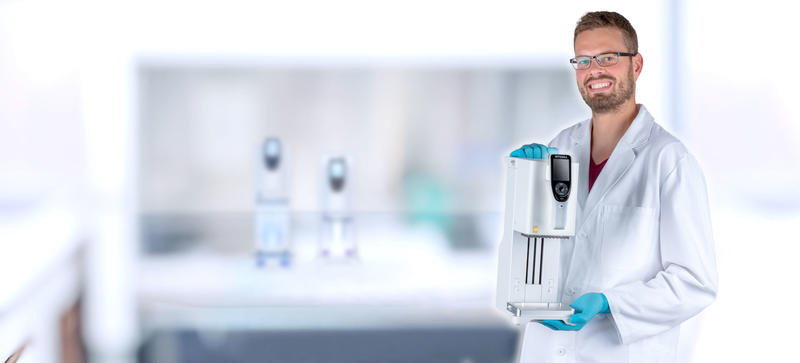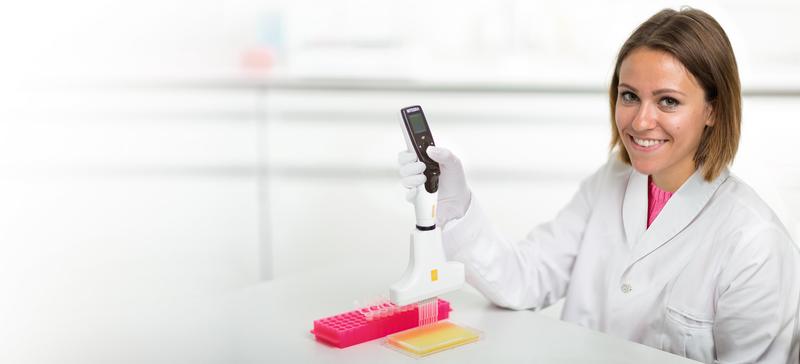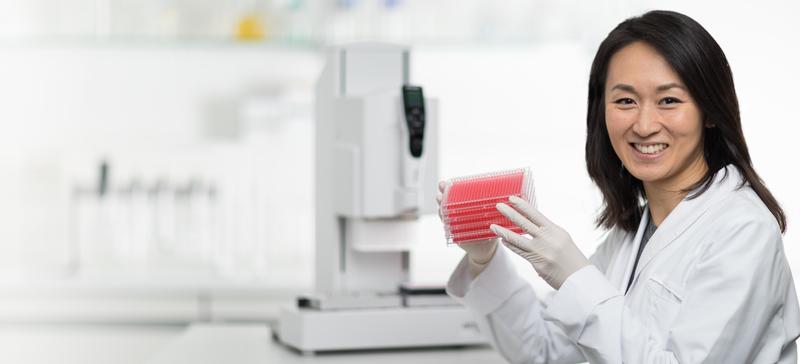-
Automated DNA normalization for NGS library prep
Effortless normalization for 16S metagenomic Illumina sequencing
Next generation sequencing (NGS) is used for DNA and RNA sequencing in basic, applied and clinical research, as well as diagnostics. NGS was originally called ‘massively parallel sequencing’, referring to its capacity to analyze millions of sequencing reactions at the same time. At the start of the NGS workflow, libraries of similarly sized DNA fragments are created. Normalization of these DNA libraries is then performed, as differences in the concentrations of fragments affect the sequencing results, leading to under- or over-representation of individual fragments.
Normalization of nucleic acid concentrations – the equalization of sample concentrations – essentially involves dilution of the sample with varying volumes of diluent. Manual DNA normalization is error-prone and tedious and requires cumbersome calculations and constant focus to ensure accurate sample tracking.
The ASSIST PLUS pipetting robot can be paired with the D-ONE single channel pipetting module to provide an easy automated solution for library normalization, ensuring error-free dilution calculations, consistent pipetting steps and precise liquid handling.
-
Table of contents
Next generation sequencing (NGS) is used for DNA and RNA sequencing in basic, applied and clinical research, as well as diagnostics. NGS was originally called ‘massively parallel sequencing’, referring to its capacity to analyze millions of sequencing reactions at the same time. At the start of the NGS workflow, libraries of similarly sized DNA fragments are created. Normalization of these DNA libraries is then performed, as differences in the concentrations of fragments affect the sequencing results, leading to under- or over-representation of individual fragments.
Normalization of nucleic acid concentrations – the equalization of sample concentrations – essentially involves dilution of the sample with varying volumes of diluent. Manual DNA normalization is error-prone and tedious and requires cumbersome calculations and constant focus to ensure accurate sample tracking.
The ASSIST PLUS pipetting robot can be paired with the D-ONE single channel pipetting module to provide an easy automated solution for library normalization, ensuring error-free dilution calculations, consistent pipetting steps and precise liquid handling.
Key benefits
- Automating the D-ONE single channel pipetting module on the ASSIST PLUS pipetting robot provides hands-off, secure processing of library normalization with high accuracy and increased reproducibility.
- The dilution calculator in VIALAB eliminates errors in dilution calculations.
- High precision pipetting results are guaranteed across a wide dynamic volume range, thanks to automatic selection of the correct pipette tip size.
- Optimal pipetting height is achieved by the automatic liquid level detection (LLD). There is no need to specify initial volumes, which makes the program set-up easier and faster.
- No need to input countless values into VIALAB, since worklists can be imported in a .csv format. The template file – with preprepared column tags – makes data transfer even easier for the user.
- A run report summarizes all diluent and sample transfer volumes, giving full traceability.
Downloads: App note and protocols for the effortless DNA library normalization using the ASSIST PLUS pipetting robot equipped with the D-ONE single channel pipetting module
Here you can download the complete protocols and reports used in this application and use them on your ASSIST PLUS and D-ONE. The protocol can be customized with the VIALAB software.
Overview: How to perform sample normalization for Illumina 16S metagenomic sequencing
This application note describes the automation of DNA library normalization. The protocol is based on Illumina's 16S Metagenomic Sequencing Library Preparation Guide. After quantifying the DNA libraries, the DNA concentrations should be calculated in nM concentration (see a calculation example for 500 bp long amplicons in the DNA concentration calculation Microsoft Excel® sheet). For sequencing, the libraries should be diluted to a concentration of 4 nM. The 'Normalization worklist' programming step allows the user to import a worklist with sample details and concentrations (Figure 1).
The dilution calculator (Figure 2) in VIALAB automatically determines the correct volume of each sample and diluent based on the target concentration (4 nM) and target volume (50 µl). It also automatically selects the best-suited pipette tip size.
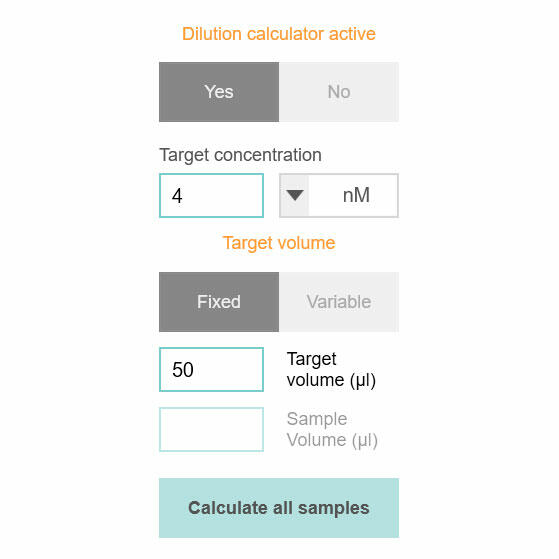
Step-by-step procedure:
The ASSIST PLUS pipetting robot is used together with the 0.5-300 µl D-ONE single channel pipetting module and 12.5 µl and 300 µl Sterile, Filter GRIPTIPS® to automate the pipetting steps of sample normalization for Illumina 16S metagenomic sequencing (Figure 3).
The normalization protocol consists of two steps:
- Transfer of the diluent
- Transfer of the samples
Experimental set-up
Deck position A: Diluent – 10 ml multichannel reagent reservoir
Deck position B: Source plate – Sapphire 96 well PCR plate (Greiner Bio-one)
Deck position C: Target plate – Sapphire 96 well PCR plate (Greiner Bio-one)
1.Transfer of diluent
The diluent is added in repeat dispense steps.
Place the 10 ml multichannel reagent reservoir on deck position A and fill it with 5 ml of 10 mM Tris (pH 8.5) buffer (Figure 4, blue with a white drop). Next, place the source plate (Sapphire 96 well PCR plate) with the amplicon samples on position B (Figure 4, colored circles) and an empty Sapphire 96 well PCR plate on position C (Figure 4, colored circles with dots); this will be the target plate containing the diluted, normalized samples.
Select and run the VIALAB program 'Illumina amplicon normalization'. The system first transfers the calculated diluent volumes to each well in several repeat-dispense steps with tip touch (Figure 5). A 15 µl pre- and post-dispense ensures precision while pipetting, and the total volume for each aspiration is calculated automatically. This is the fastest way of dispensing different volumes with a single channel pipette, saving time and money while reducing tip usage.
Tip:
- Pre- and post-dispense settings, together with the tip touch, guarantee precise and accurate pipetting results.
2. Transfer of the samples
The samples are transferred one by one.
After dispensing the diluent, the ASSIST PLUS pipetting robot starts to add the amplicon samples from the source plate to the target plate in individual transfer steps (Figure 6).
The amplicon sample volumes in the source plate may be different. If the liquid level detection (LLD) (Figure 7) is activated, the optimal pipetting height is automatically detected and allows the pipette tip to follow the liquid level during aspiration. This constant submerge depth during aspiration contributes to precise pipetting results. At the end of every transfer step, the sample is mixed thoroughly with the diluent in three mixing cycles.
Tip:
- Pipetting parameters (pipetting speed, pre-wetting, tip change) and the mixing conditions (height, speed, cycle and volume) can easily be adjusted in the VIALAB program if needed.
Now the normalized libraries are ready to be aliquoted and pooled for sequencing.
Remarks
- VIALAB software: VIALAB programs can be easily adapted to the user’s specific labware and protocols.
- Run report: If the ASSIST PLUS pipetting robot is connected to the PC with VIALAB, programs can be started directly from the PC. After the run, a run report is automatically generated, documenting details such as the start/end time, user, calculated volumes, and any errors that occurred. This offers a convenient way to fulfill regulatory requirements.
Conclusion
- The ASSIST PLUS pipetting robot equipped with the D-ONE single channel pipetting module is the perfect solution for DNA normalization for NGS. With the push of a button accurate, error-free sample dilutions can be achieved.
- Several VIALAB features help the user to set up normalization quickly and easily. The dilution calculator determines the diluent and sample volumes, and automatically chooses the best pipette tip size to ensure perfect pipetting results. Worklists can be directly imported to VIALAB, saving the user from time-consuming, wearisome and error-prone typing.
- The D-ONE single channel pipetting module performs automatic LLD to overcome the differing liquid levels of samples, ensuring the optimal aspiration height and precise pipetting.
- Each D-ONE single channel pipetting module is compatible with two types of GRIPTIP to provide a broad volume range. This ensures longer walk-away times and eliminates the need to change the pipette between pipetting steps.
Related articles
Further reading:
Ask our expert. Leave a comment!
Write us if you have any questions regarding the application note or one of our instruments.
Any questions? I'm happy to help!
Instruments and accessories
ASSIST PLUS, Pipetting Robot
INTEGRA has developed the ASSIST PLUS pipetting robot to streamline routine pipetting tasks at an affordable price. Using INTEGRA electronic multichannel pipettes, the system:
- automates pipetting tasks,
- eliminates physical strain and
- ensures superior reproducibility and
- error free pipetting.
Part No. 4505
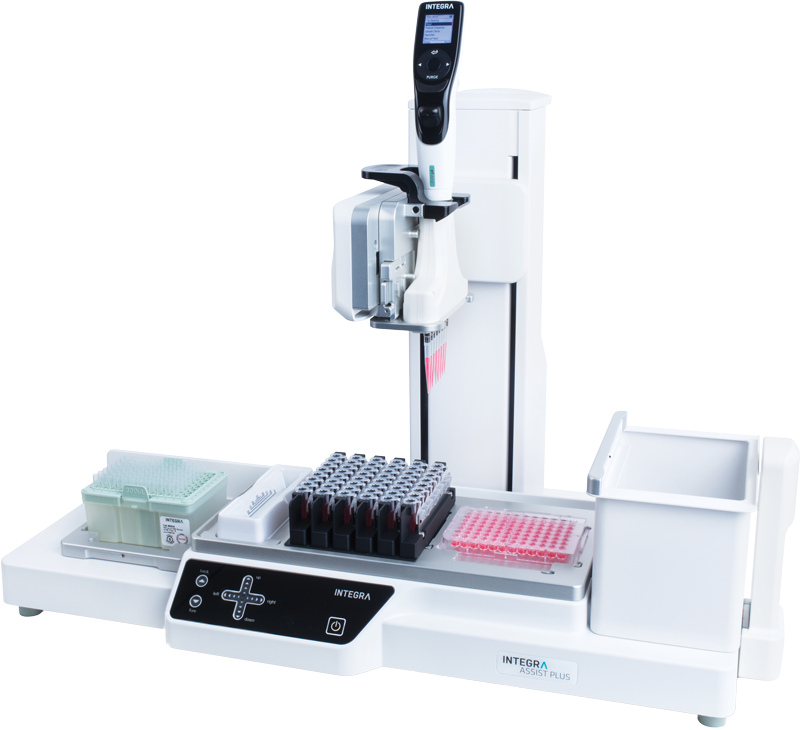
D-ONE Single Channel Pipetting Module, 0.5-300 µl
The D-ONE single channel pipetting module offers hands-free transfers from individual tubes or wells on the ASSIST PLUS pipetting robot. This makes it the perfect add-on for labs that want to go beyond the possibilities of multichannel pipetting to access unlimited applications. It is designed to offer easy automation of normalization, hit picking and master mix preparation, freeing up your time while eliminating transcription errors.
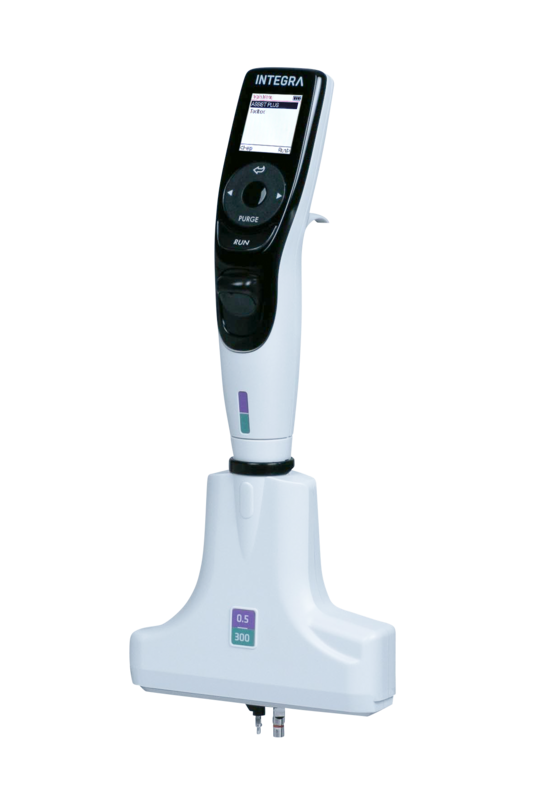
Tip deck for D-ONE on ASSIST PLUS
- Supports accommodation of 1 x 12.5 µl/ 125 µl tip box and 1 x 300 µl/ 1250 µl tip box
- Compatible with D-ONE Pipetting Module 0.5 - 300 µl and 5 - 1250 µl
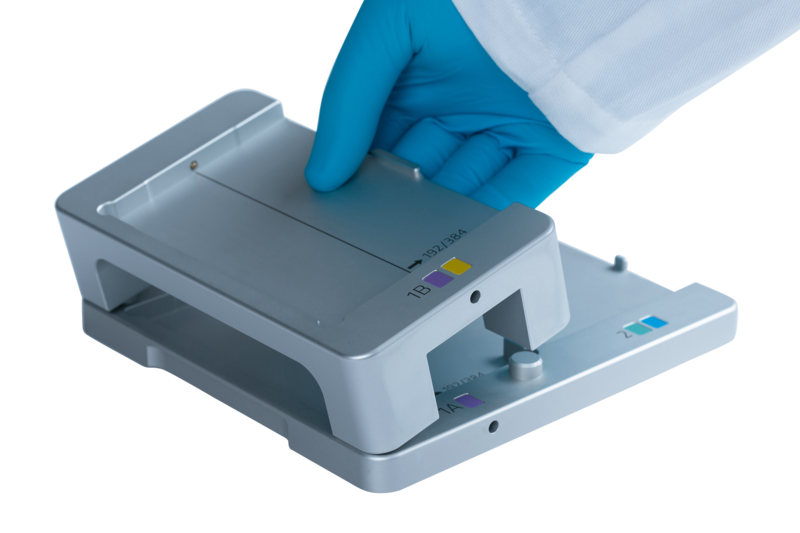
GRIPTIPS®, 300 µl, Sterile, Filter
GRIPTIPS® pipette tips perfectly match the multi-lobe tip fitting, snapping firmly on during loading. This guarantees a perfect seal on every tip, preventing them from loosening, leaking or completely falling off. All tips are precisely aligned horizontally, enabling accurate touch-offs, even when pipetting with 384 tips.
Part No. 3435
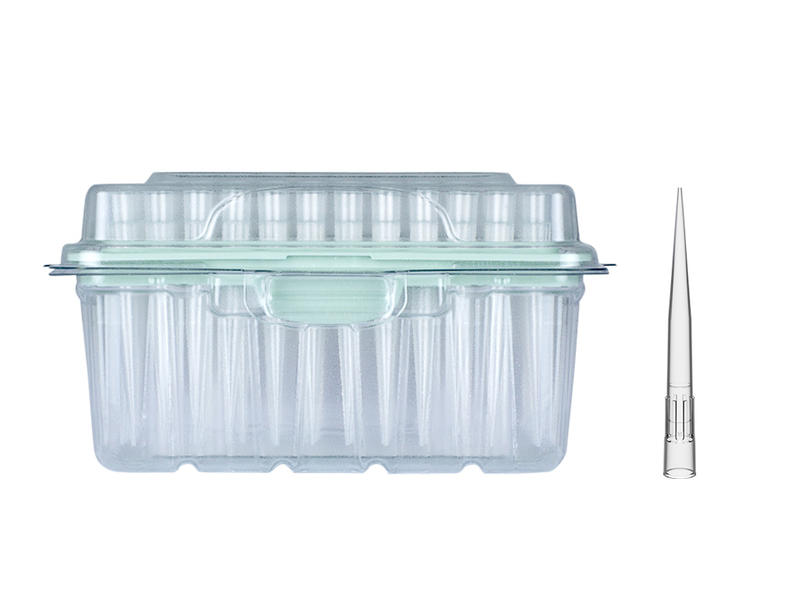
GRIPTIPS®, 12.5 µl, Sterile, Filter
GRIPTIPS® pipette tips perfectly match the multi-lobe tip fitting, snapping firmly on during loading. This guarantees a perfect seal on every tip, preventing them from loosening, leaking or completely falling off. All tips are precisely aligned horizontally, enabling accurate touch-offs, even when pipetting with 384 tips.
Part No. 4415
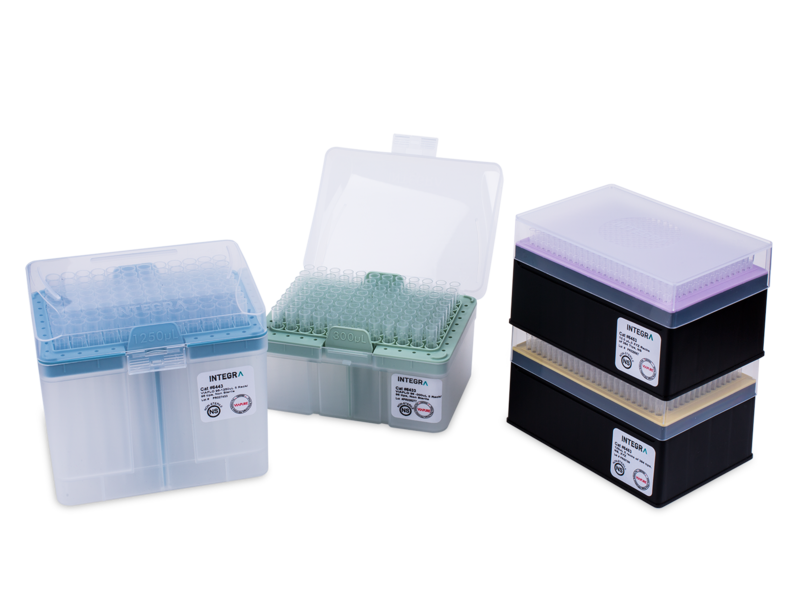
Greiner Bio-One: Sapphire microplate, 96 well, PP
- Free of detectable DNase, RNase, human DNA
- Non-Pyrogenic
- Ultra thin polypropylene for optimal heat transfer from the thermoblock to the reaction solution
- Are particularly suited for automation
- They are both "robot-freindly" for grippers, and have sufficient space for the application of barcodes
- Sealable with sealers "SILVERseal™", "VIEWseal™" and "AMPLIseal™"
- Volume per well: 0.2 ml
- Full-skirted
Source: Website supplier
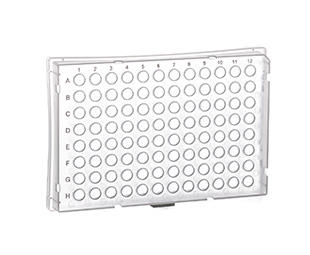
Multichannel Reagent Reservoir, 10 ml, PP
- SureFlo™ anti-sealing array prevents pipette tip seal off which can cause liquid to pop into the tip, filter or even the pipette itself
- Unique surface treatment spreads liquid evenly offering even lower dead volumes
- Reusable base with bold, crisp, clearly visible graduation markings
- Nest inside each other, making it possible to get twice as many reservoirs in half the space of other products on the market
- Reducing inventory space requirements and shipping costs
- Available as crystal clear polystyrene reservoirs or polypropylene reservoirs for improved chemical compatibility
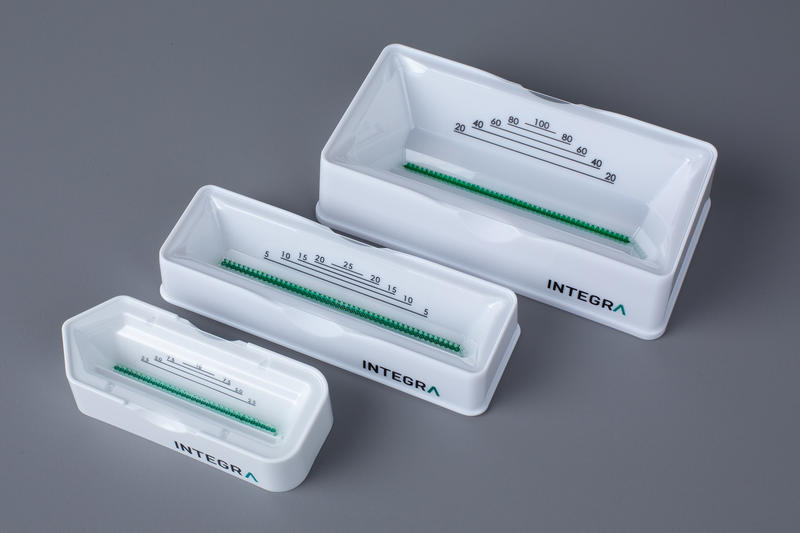
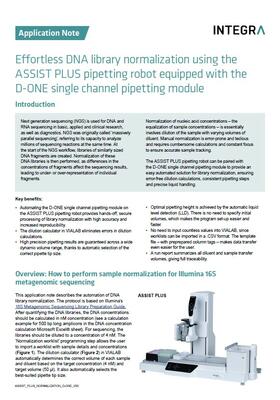
Customer’s voice
Autonomous Genius that Gives My Shoulders a Break!
"The quality and more importantly, the consistency of the ASSIST-plus makes an MLT’s life a whole lot easier! Pipetting by hand for 8 hours can take a toll on you, but when you’re ready to plate a 384, the ASSISTplus is a breath of fresh air!"

